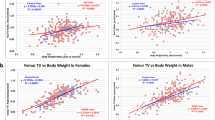Abstract
Do body size components, such as weights of internal organs and long bone lengths, with different functions and different developmental histories also have different genetic architectures and pleiotropic patterns? We examine murine quantitative trait loci (QTL) for necropsy weight, four long bone lengths, and four organ weights in the LG/J × SM/J intercross. Differences between trait categories were found in number of QTL, dominance, and pleiotropic patterns. Ninety-seven QTLs for individual traits were identified: 52 for long bone lengths, 30 for organ weights, and 15 for necropsy weight. Results for long bones are typically more highly significant than for organs. Organ weights were more frequently over- or underdominant than long bone lengths or necropsy weight. The single-trait QTLs map to 35 pleiotropic loci. Long bones are much more frequently affected in groups while organs tend to be affected singly or in pairs. Organs and long bones are found at the same locus in only 11 cases, 8 of which also include necropsy weight. Our results suggest mainly separate genetic modules for organ weights and long bone lengths, with a few loci that affect overall body size. Antagonistic pleiotropy, in which a locus has opposite effects on different characteristics, is uncommon.


Similar content being viewed by others
References
Brockmann GA, Karatayli E, Haley CS, Renne U, Rottmann OJ, et al. (2004) QTLs for pre- and postweaning body weight and body composition in selected mice. Mamm Genome 15(8):593–609
Chai C (1956a) Analysis of quantitative inheritance of body size in mice. I. Hybridization and maternal influences. Genetics 41(2):157–164
Chai C (1956b) Analysis of quantitative inheritance of body size in mice. II. Gene action and segregation. Genetics 41(2):167–178
Chai C (1957) Analysis of quantitative inheritance of body size in mice. III. Dominance. Genetics 42(5):601–607
Cheverud JM (2000) Detecting epistasis among quantitative trait loci. In Epistasis and the Evolutionary Process, Wolf JB, Brodie ED III, Wade MJ (eds.) (New York: Oxford University Press), pp 58–81
Cheverud JM, Routman EJ, Duarte FA, van Swinderen B, Cothran K, et al. (1996) Quantitative trait loci for murine growth. Genetics 142(4):1305–1319
Cheverud JM, Routman EJ, et al. (1997) Pleiotropic effects of individual gene loci on mandibular morphology. Evolution Int J Org Evolution 51(6):2006–2016
Cheverud JM, Vaughn TT, Pletscher LS, King-Ellison K, Bailiff J et al. (1999) Epistasis and the evolution of additive genetic variance in populations that pass through a bottleneck. Evolution Int J Org Evolution 53(4):1009–1018
Cheverud JM, Vaughn TT, Pletscher LS, Peripato AC, Adams ES, et al. (2001) Genetic architecture of adiposity in the cross of LG/J and SM/J inbred mice. Mamm Genome 12(1):3–12
Cheverud JM, Ehrich TH, Hrbek T, Kenney JP, Pletscher LS, et al. (2004) Quantitative trait loci for obesity- and diabetes-related traits and their dietary responses to high-fat feeding in LGXSM recombinant inbred mouse strains. Diabetes 53(12):3328–3336
Christians JK, Bingham VK, Oliver FK, Heath Tt, Keightley PD (2002) Characterization of a QTL affecting skeletal size in mice. Mamm Genome 14(3):175–183
Ehrich TH, Vaughn TT, Koreishi SF, Linsey RB, Pletscher LS, et al. (2003) Pleiotropic effects on mandibular morphology I. Developmental morphological integration and differential dominance. J Exp Zoolog B Mol Dev Evol 296(1):58–79
Eisen EJ (1975) Population size and selection intensity effects on long-term selection repsonse in mice. Genetics 79:305–323
Falconer DS (1955) Patterns of response in selection experiments with mice. Cold Spring Harbor Symp Quant Biol 20:178–196
Goodale H (1938) A study of the inheritance of body weight in the albino mouse by selection. J Hered 29:101–112
Haley CS, Knott SA (1992) A simple regression method for mapping quantitative trait loci in line crosses using flanking markers. Heredity 69(4):315–324
Hrbek T, Alves de Brito R, Wang B, Pletscher LS, Cheverud JM (2006) Genetic characterization of a new set of recombinant inbred lines (LG/JxSM/J) formed from the intercross of SM/J and LG/J inbred mouse strains. Mamm Genome 17, 417–429
Knott SA, Haley CS (2000) Multitrait least squares for quantitative trait loci detection. Genetics 156(2):899–911
Kramer MG, Vaughn TT, Pletscher LS, King-Ellison K, Adams E et al. (1998) Genetic variation in body weight gain and composition in the intercross of Large (LG/J) and Small (SM/J) inbred strains of mice. Genet Mol Biol 21(2):211–218
Lander ES, Green P, Abrahamson J, Barlow A, Daly A, et al. (1987) MAPMAKER: an interactive computer package for constructing primary genetic linkage maps of experimental and natural populations. Genomics 1(2):174–181
Leamy LJ, Pomp D, Elsen EJ, Cheverud JM (2002) Pleiotropy of quantitative trait loci for organ weights and limb bone lengths in mice. Physiol Genomics 10(1):21–29
Lincoln SE, Lander ES (1992) Systematic detection of errors in genetic linkage data. Genomics 14(3):604–610
Lionikas A, Blizard DA, Vandenbergh DJ, Glover MG, Stout JT, et al. (2003) Genetic architecture of fast- and slow-twitch skeletal muscle weight in 200-day-old mice of the C57BL/6J and DBA/2J lineage. Physiol Genomics 16(1):141–152
MacArthur JW (1949) Selection for small and large body size in the house mouse. Genetics 34:194–209
Pérusse L, Rankinen T, Zuberi A, Chagnon YC, Weisnagel SJ, et al. (2005) The human obesity gene map: the 2004 update. Obes Res 13:381–490
Rocha JL, Eisen EJ, Van Vleck LD, Pomp D (2004) A large-sample QTL study in mice: II. Body composition. Mamm Genome 15(2):100–113
Routman EJ, Cheverud JM (1995) Polymorphism for PCR-analyzed microsatellites between the inbred mouse strains LG and SM. Mamm Genome 6(6):401–404
Vaughn TT, Pletscher LS, Peripato A, King-Ellison K, Adams E, et al. (1999) Mapping quantitative trait loci for murine growth: a closer look at genetic architecture. Genet Res 74(3):313–322
Acknowledgments
This work was supported in part by National Institutes of Health grants RR-15116, DK55736, DK-52514, and HL-58427.
Author information
Authors and Affiliations
Corresponding author
Appendix A
Appendix A
Rights and permissions
About this article
Cite this article
Kenney-Hunt, J.P., Vaughn, T.T., Pletscher, L.S. et al. Quantitative trait loci for body size components in mice. Mamm Genome 17, 526–537 (2006). https://doi.org/10.1007/s00335-005-0160-6
Received:
Accepted:
Published:
Issue Date:
DOI: https://doi.org/10.1007/s00335-005-0160-6




